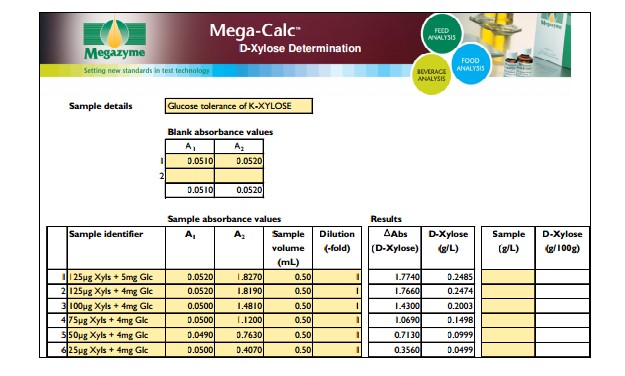- D-木糖检测试剂盒
-
英文名:D-Xylose assay Kit
-
货号:K-XYLOSE
-
规格:100 assays (manual) / 1000 assays (microplate)
- Very cost effective
- All reagents stable for > 2 years after preparation
- Only enzymatic kit available
- Rapid reaction (~ 6 min)
- Mega-Calc™ software tool is available from our website for hassle-free raw data processing
- Standard included
- Suitable for manual, microplate and auto-analyser formats
- Ensure that you have tested the standard sample that is supplied with the Megazyme test kit.
- Send the results of the kit standard, blank samples and the results obtained for your sample, in the relevant MegaCalc spreadsheet (if available) to Megazyme (cs@megazyme.com). Where available the relevant MegaCalc spreadsheet can be downloaded from where the product appears on the Megazyme website.
- State the kit lot number being used (this is found on the outside of the kit box).
- State which assay format was used (refer to the relevant page in the kit booklet if necessary).
- State exact details of any modifications to the standard procedure that is provided by Megazyme.
- State the sample type and describe the sample preparation steps if applicable.
市场价: 4452元
The D-Xylose test kit is a novel method for the specific, convenient and rapid measurement and analysis of D-xylose in plant extracts, culture media/supernatants and other materials.
Suitable for manual, auto-analyser and microplate formats.
UV-method for the determination of D-Xylose in fermentation
broths and hydrolysates of plant material and polysaccharides
Principle:
(xylose mutarotase)
(1) α-D-Xylose ↔ β-D-xylose
(β-xylose dehydrogenase)
(2) β-D-Xylose + NAD+ → D-xylonic acid + NADH + H+
Kit size: 100 assays (manual) / 1000 (microplate)
/ 1300 (auto-analyser)
Method: Spectrophotometric at 340 nm
Reaction time: ~ 6 min
Detection limit: 0.7 mg/L
Application examples:
Analysis of D-xylose in fermentation broths and hydrolysates of plant
material and polysaccharides
Method recognition: Novel method
Advantages
Q1. Sometimes a negative absorbance change is obtained for the blank samples, is this normal? Should the real value (negative absorbance change) or “0” be used in the calculation of results?
Sometimes the addition of the last assay component can cause a small negative absorbance change in the blank samples due to a dilution effect and in such cases it is recommended that the real absorbance values be used in the calculation of results.
Q2. Should the pH of the sample be adjusted even for samples in acidic media?
The pH of the assay solution after the sample is added should be the same as that of the assay buffer that is supplied with the kit.
Low sample volumes (e.g. 0.1 mL) are not likely to affect the pH of the assay solution and therefore may not require pH adjustment.
Samples above 0.1 mL are more likely to affect the pH of the assay solution and therefore the pH of these samples should be adjusted as described in the data booklet, prior to addition to the assay.
Q3. There is an issue with the performance of the kit; the results are not as expected.
If you suspect that the Megazyme test kit is not performing as expected such that expected results are not obtained please do the following:
Q4. Can the K-XYLOSE test be used to measure D-xylose in urine samples?
Yes. K-XYLOSE can be used to measure D-xylose in urine samples assuming that the D-xylose concentration is above the limit of detection for the kit assay after sample preparation. An example sample preparation method for biological samples is provided in the K-XYLOSE data booklet.
Q5. What level of glucose can the K-XYLOSE assay tolerate before interference is observed?
K-XYLOSE is able to specifically measure xylose in samples that contain up to 5 mg of glucose in the final assay reaction without any interference by the glucose.

Q6. Can oligosaccharides or polysaccharides be measured using the kit assay?
The kit assay will only measure the non-covalently linked monosaccharide.
Oligosaccharides or polysaccharides can be measured after hydrolysis to the monosaccharide. Generally acid hydrolysis can be achieved by boiling the oligo/polysaccharide in 1.3 M HCl for 1 h. It is recommended that scientific literature is consulted for information on hydrolysis conditions for the particular oligo/polysaccharide that is being measured.
Q7. Is it possible to add a larger volume then 2 μL of enzyme to the microplate assay? In some instances 2 μL can be difficult to pipette manually.
Yes, instead of adding 2 μL of enzyme suspension an alternative is to dilute the enzyme and add a larger volume to the microplate assay.
Dilute the assay buffer 10-fold with distilled water and use this as the diluent to dilute an aliquot of the enzyme suspension also by 10-fold. Instead of 2 μL, use 20 μL of the diluted enzyme in the microplate assay.
Megazyme D-木糖检测试剂盒操作视频(K-XYLOSE)
Megazyme 溶解淀粉 操作视频
Megazyme 试剂盒样品前处理准备操作视频
